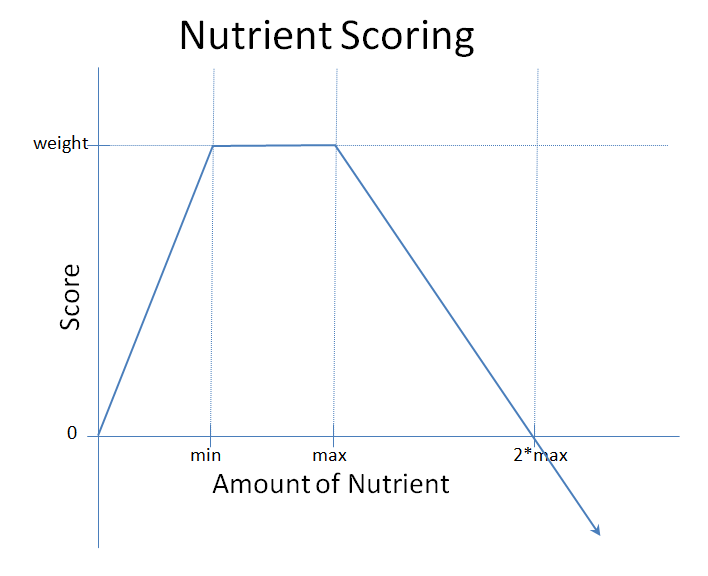Part of the Food Cost Calculator project is to determine the nutritional value of different foods. The program can be used to calculate the cost of a food per calorie or weight. But I also want it to calculate the overall nutritional value of the food and the cost per nutrient.
There are certainly a lot of different opinions about what makes a food healthy. The program will have flexibility for a user to set up the scoring system based on the nutrients available in the USDA database.
One way to score a food is to calculate how much of the recommended vitamins/minerals the food provides. Another thing to consider may be the amount of fat/carbohydrate/protein in the food.
This post will describe the scoring system in the food cost program and how I setup the scoring system for myself.
The score of a food is independent of the number of calories in a particular amount of the food. When a food is scored, the program pretends that food is the only thing you ate all day. So if it is scoring a 200 calorie food and you want 2000 calories per day, it will multiply all the nutrient amounts by 10.
All the nutrients that the program tracks aren’t equally important. People have different dietary goals or restrictions, so the program lets the user set a “weight” for each nutrient. A particular nutrient can score up to its “weight” in points. I setup my weights so that they add up to 100. That way a food can, at most, score 100 points.
Once the nutrient amounts have been scaled to a full day of calories, each nutrient amount is compared to the desired range of that nutrient. If the amount is within the desired range the score is 100% of the weight. If it is outside the range the score is reduced.
 There are three types of nutrients.
There are three types of nutrients.
- “Good” nutrients where you want at least X grams. For this type of nutrient, I set the min to the amount that I want and the max to infinity.
- “Good in moderation” nutrients, where you want between the min and the max.
- “Bad” nutrients where you want no more than X grams. For this type of nutrient, I set the min to zero and the max to the most I want to get in a day.
Vitamins and Minerals
The FDA publishes several guidelines for how much of each vitamin and mineral a person needs. First is the “Dietary Reference Intakes: Recommended Dietary Allowance” which is the minimum daily intake to satisfy the needs of 97% of people. They also publish a “Dietary Reference Intakes: Tolerable Upper Intake” which is the highest daily intake that should pose no risk to otherwise healthy people. Some vitamins and minerals have no upper limits.
I am not certain that these are definitive values, the science is probably somewhat fuzzy and there are probably variations by weight and activity level that aren’t captured in these recommendations. But they are reasonable values.
Fats
The FDA recommends that adults get 20-35% of their calories from fat. Of course this recommendation is controversial, with different groups and diets recommending widely different values. I personally agree with this recommendation and feel that the important factor is the type of fat. The RDA recommends keeping consumption of saturated fat and trans fat as low as possible and getting 5-10% of calories from omega-6, 0.6-1.2% of calories from omega-3. I set the daily limits for trans fat and saturated fat to 5 grams and 1 gram respectively.
Carbohydrates and Protein
The FDA recommends that adults get 45-65% of their calories from carbohydrates and 10-35% from protein. Like the fat recommendation, there isn’t much agreement between different diets about these numbers, but they seem reasonable to me.
The FDA recommends 38 grams of fiber per day. This number is independent of calories. They also recommend that added sugars make up less that 25% of the calories. Unfortunately, the USDA database doesn’t distinguish between “added” sugars and naturally occurring sugars. I feel like 25% of calories from added sugar is too much, so I just went with 25% of calories from any sugar.
Cholesterol
The FDA includes cholesterol in the list of nutrients that you should limit to as little as possible. The American Heart Association recommends no more that 300 mg per day. However, recent studies have shown very little correlation between dietary cholesterol and blood cholesterol. I set my daily maximum to 500 mg.
Sodium and Potassium
The FDA recommends 1500-2300 mg of sodium for people under 50, 1300-2300 mg between 50 and 70 and 1200-2300 mg for people over 70. The American Heart Association recommends no more than 1500 mg per day. I feel like I am easily affected by salt and so I should limit my intake. I set my range from 1200-1500 mg.
The FDA recommends at least 4700 mg of potassium per day.
All nutrient ranges and weights
[table]Nutrient, Minimum, Maximum, Weight
Calories,1700,1900,0
Fat(g),40,70,5
Saturated fat(g),0,5,5
Monounsaturated fat(g),25,40,2
Polyunsaturated fat(g),15,30,2
Omega-3(g),1.2,2.4,2
Omega-6(g),10,20,2
Trans fat(g),0,1,5
Cholesterol(mg),0,500,2
Sodium(mg),1200,1500,7
Potassium(mg),4700,–,7
Carbohydrate(g),203,293,5
Fiber(g),38,–,8
Sugar(g),0,112,8
Protein(g),45,157,15
Vitamin A,900,3000,1
Vitamin E,15,1000,1
Vitamin D,15,100,1
Vitamin C,90,2000,1
Vitamin K,120,–,1
Thiamin (B1),1.2,–,1
Riboflavin (B2),1.4,–,1
Niacin (B3),16,35,1
Pantothenic acid (B5),5,–,1
Vitamin B6,1.3,100,1
Folate DFE (B9),400,1000,1
Vitamin B12,2.4,–,1
Calcium,1000,–,1
Iron,6,–,1
Magnesium,420,–,1
Phosphorus,700,–,1
Zinc,11,–,1
Copper,0.7,–,1
Manganese,2.3,–,1
Selenium,55,–,1
Water(g),2800,–,5
[/table]